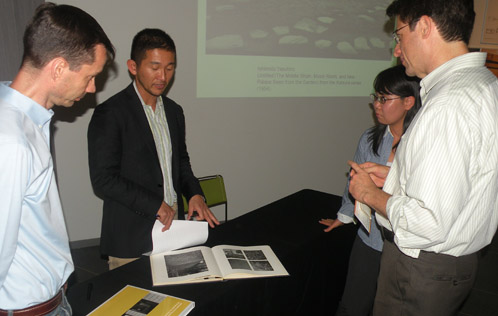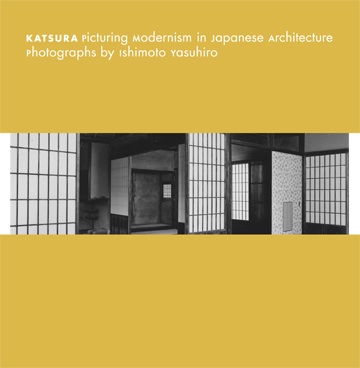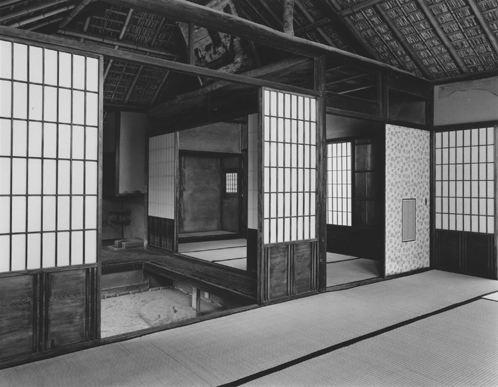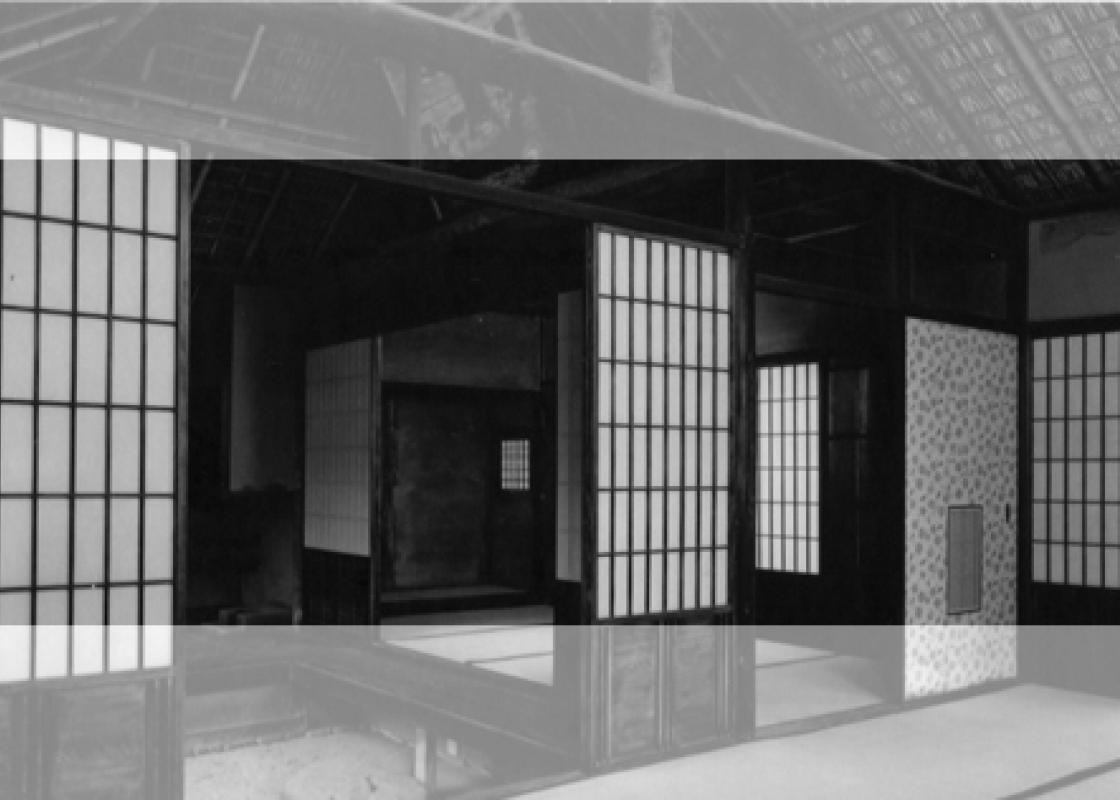
Yasufumi Nakamori gave a talk at the Architecture Center Houston. Photo by Hank Hancock.
On Wednesday, April 20, Yasufumi Nakamori, assistant curator of photography at The Museum of Fine Arts, Houston, spoke about his recent scholarship to an audience invited by the Houston Public Library and hosted by Architecture Center Houston (ArCH) downtown for their series “Authors in Architecture.” Nakamori, having just hours earlier returned from Japan, presented an informal survey of Katsura: Picturing Modernism in Japanese Architecture; Photographs by Ishimoto Yasuhiro, the catalogue for the Summer 2010 MFAH exhibit.
Ishimoto’s photography is familiar to museum visitors through his photographs of Chicago streets, stairwells, and children, responding in part to the “New Bauhaus” aesthetic flourishing there just after World War II. Born in San Francisco, raised and schooled in Japan, he returned to the states to study architecture and then was put in an internment camp for two years in Colorado, where at age 21, he took up photography. With his dual cultural and geographical identity, Ishimoto quickly made a name for himself in Chicago, placing work in exhibitions, winning contests, publishing photos in Life magazine, and winning significant commissions, including one for the landmark "Family of Man" (1956). Nakamori identifies Mies van der Rohe and photographer Harry Callahan as formative influences for Ishimoto Yasuhiro.

Katsura book cover
Nakamori, assisted by a slide show featuring many of the plates from the catalogue, explained how Ishimoto returned to Japan in 1953 and 1954 to photograph Japan’s pre-modern architectural treasures and became particularly absorbed by the seventeenth-century Katsura Imperial Villa in Kyoto. Ishimoto documented with an eye toward material surfaces, the striking convergence of the garden and the palace, and decontextualized architectural detail, not to mention his ongoing interests in ephemeral detail as in the cast of sunlight and the shadows of trees on the grounds. Katsura had long been a subject of study and discussion, but it gained new significance in post-occupation Japan’s “tradition debate,” (dentō ronsō), wherein the villa no longer stood for timeless tradition, but as a means to understand Japan’s modernity. This was especially true once Walter Gropius visited the site and said as much himself. Ishimoto, on his own, had made explicit comparisons between the villa and Piet Mondrian’s groundbreaking forms.
Aiming simply to publish a book of photographs of Katsura, Ishimoto requested from Tange Kenzo, ten years his senior and by then a towering figure in Japanese architecture, the contribution of an accompanying essay. Tange was also an avid photographer, and he perceived many similar interests and aesthetic approaches with the young Ishimoto. He went much further than contributing an essay, ultimately taking control of the book project to pursue his own statement about modernity and tradition, his turn toward structuralism, and a need to disentangle the traditionalist from the imperialist. He considered the camera as a central part of architectural thinking. Tange once described Katsura, despite its central place in his thesis, as like a beloved woman who is beautiful in photographs but less impressive in person. Photography made it possible to think about tradition and modernity as part of an “internal reality.”
Tange took charge of Ishimoto’s photos, cropped them “drastically,” hired Bauhaus graphic designer Herbert Bayer to plan the layout, and then went on to fire Bayer so that he could select and sequence the photos himself, contracted with Gropius for another essay, and then released the book Tradition and Creation in Japanese Architecture in 1960, by which time Ishimoto had fairly disengaged from the whole project.
The book continues to enjoy its status as the foundational text in modern Japanese architecture. Nakamori pointed to the ArCH’s concurrent exhibit “Parallel Nippon: Contemporary Japanese Architecture, 1996-2006,” which was hung on the walls of the large multi-purpose space where the talk was held. It showed work by dozens of firms and designers, saying “All these architects, if you asked which is the one book that sets the stage, this one would be it.”

Uncropped photo by Ishimoto Yasuhiro
Nakamori’s MFAH exhibit and his own book for the first time fully showed Ishimoto’s photographs according to his own vision. Nakamori helpfully held the 1960 book and his own side-by-side, confirming their inter-relationship: they were identical in size and shape and share several font choices. (Nakamori’s book was designed by Daphne Geismar.) Both were published by Yale University Press.
It’s not entirely accurate to say that Tange’s “incredible interventions” somehow distorted or damaged Ishimoto’s work, as several questions from the audience seemed to presume. Ishimoto, who became a naturalized Japanese citizen in 1961, actually shared many of Tange's ideas about photography and architecture, and the photos may even have helped Tange to clarify his own theoretical program. Ishimoto himself has made contradictory assessments of the book over the years, that his vision was obscured or that it was honored, and will admit that the Tange book helped to confirm his place as a leading Japanese photographer, whose long career we continue to study and discuss.
Ishimoto Yasuhiro, Untitled, from the series Katsura, 1953-54, Gelatin silver print, printed 1980-81, The Museum of Fine Arts, Houston, gift of the artist in memory of Ishimoto Shigeru
Related Link
Katsura: Picturing Modernism in Japanese Architecture Wins CAA Prize
An MFAH interview with Yasufumi Nakamori (March 10, 2011)










